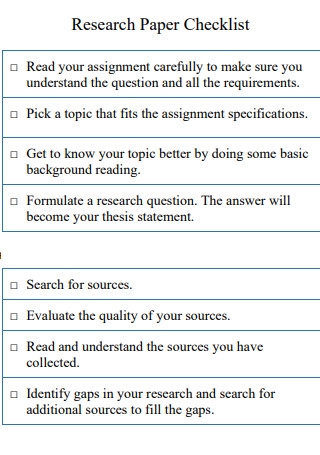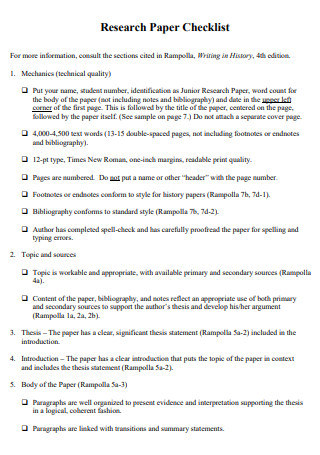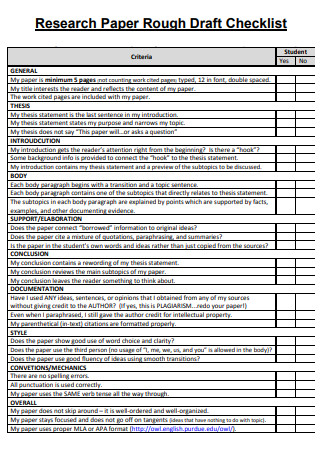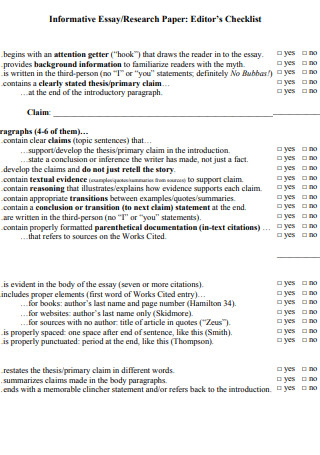19+ SAMPLE Research Paper Checklist
-

Personalized Research Paper Checklist
download now -

Research Paper Checklist Format
download now -

Research Paper Preparation Checklist
download now -

Sociology Research Paper Checklist
download now -

Research Paper Rubric Checklist
download now -

Senior Research Paper Checklist
download now -

General Research Paper Checklist
download now -

University Research Paper Checklist
download now -

Checklist for Research Papers
download now -

Sample Research Paper Checklist
download now -

Research Paper Rough Draft Checklist
download now -

Research Paper Checklist
download now -

Research Paper Contents Checklist
download now -

Research Paper Checklist and Outline
download now -

Research Paper Editor Checklist
download now -

Reviewers Checklist for Research Papers
download now -

Exegetical Research Paper Checklist
download now -

Baisc Research Paper Checklist
download now -

Research Generic Paper Checklist
download now -

Research Paper Peer Review Checklist
download now
FREE Research Paper Checklist s to Download
19+ SAMPLE Research Paper Checklist
What Is a Research Paper Checklist?
Types of Research Papers
Tips for Writing a Research Paper
How to Create a Research Paper Checklist
FAQs
How do you write a checklist for a research paper?
What are the 7 parts of a research paper?
What is the format of a research paper?
What Is a Research Paper Checklist?
A research paper checklist is a checklist or a printed handout that lists all the important requirements needed in a research paper. The checklist is especially helpful to students whenever they are tasked to fulfill an academic paper or research proposal.
According to a journal article published by the U.S. National Library of Medicine and National Institute of Health, research papers- especially medical ones- always require a suitable title. There are three basic types of titles. These are descriptive, declarative, and interrogative. Other times, these titles may also be classified as nominal, compound, or full sentence titles.
Types of Research Papers
If you are a student, then you will know that research papers are a basic element in academics. There are several types of research papers, and some of the most common ones are tackled below.
Tips for Writing a Research Paper
Every student has to go through the process of crafting a research paper at least once in their academic life. Whether you are a middle school, high school, or college student, writing research papers not only helps hone your language and communication abilities, it can help sharpen critical thinking and organization skills. The next time you are assigned to write a research paper, keep in mind these essential tips:
How to Create a Research Paper Checklist
The numerous time-saving templates above can help you customize your own research paper checklist without having to start from scratch. Simply pick one that suits your needs and keep in mind the following steps below.
Step 1: Prepare the Format
To create a research paper checklist, decide on a format that works for you. Since a checklist is pretty much straightforward, create a simple table while leaving enough space for your checklist items. You can also include a checkbox before every item. The format depends entirely on you and how you would want it to look like. Choose whether or not you want to use single words, short phrases, or even complete sentences. How simple or complex the format of your research paper checklist will depend on you and your needs.
Step 2: Enumerate the Requirements
When you have established your format, fill up your checklist with the necessary items. Enumerate the requirements of your research paper either in bullet points, checkboxes, or numbers. But you do not have to be limited by just the requirements. Other ideas for what to include in your checklist are parts of the research paper, reminders, or even a series of self-revision questions about the research topic. Regardless, these items should serve as a reminder for the start, end, and over the course of your writing. It will help ensure you stay on top of your requirements.
Step 3: Include a Time Table
To take it a step further, you might want to include a time element in your checklist. There is absolutely nothing wrong with using just a simple checklist. But if you want to stay on top of deadlines or due dates, it may be helpful to include an additional column for these timely reminders. Teachers impose deadlines for submissions and the last thing you want is to miss any of these deadlines. On the other hand, you can simply place self-imposed deadlines. For example, give yourself a fixed time as to when you aim to finish writing the review of literature and all the other sections. Or specify the time frame of both the start and end dates for writing your research methodology or any other section.
Step 4: Have the Research Paper Checklist Proofread
If you are not sure if your checklist is accurate or complete, it might be a good idea to have a trusted friend double check your list. As the saying goes, two pairs of eyes are better than just one. If having a research paper peer-reviewed is necessary, then it would not hurt for your checklist to be reviewed as well. Who knows, maybe there was something you missed or overlooked, and a friend can point it out for you. This way, you can be twice as sure before proceeding to writing the actual research paper.
FAQs
How do you write a checklist for a research paper?
To write a checklist for a research paper, you can create your own from scratch or use an existing template. Doing the latter is faster and more convenient. Indicate all the requirements, parts, or reminders needed for your research paper. Enumerate them one by one. You can also add a checkbox, bullet, or number beside each item on your checklist.
What are the 7 parts of a research paper?
According to an online article by UC San Diego, the 7 major parts of a research paper are the following: the title page, abstract, introduction, methodology, results, discussion, and the references section.
What is the format of a research paper?
The two most common formats used in research paper writing is MLA and APA. According to an article published by Bibliography.com, MLA stands for Modern Language Association and is typically used in the arts and humanities when citing books and other literature. APA, on the other hand, stands for American Psychological Association. The format is intended for technical works usually found in the social sciences.
Research paper writing can be a long and tedious task. Almost every student is subjected to it as an assignment, at least once in their academic life. Let the sample templates above be your blueprint and guide as you prepare to write your research paper. Download and customize a sample research paper checklist today!
